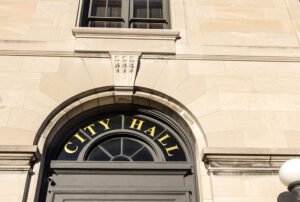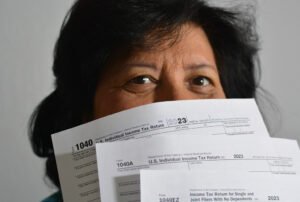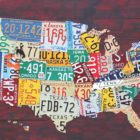
Over the next few weeks, NPQ will be running an important, five-part series on the new nonprofit regulatory environment, which will include articles on the IRS, state regulatory mechanisms, and even the trends on a global level. In this first article, Jon Pratt discusses the balance that must be struck in nonprofit regulation, a balance that both jealously protects our First Amendment rights and also requires the best of this sector as stewards of the public trust.
This article is from the summer 2016 edition of the Nonprofit Quarterly magazine, “The New Nonprofit Regulatory Environment: What You Should Know.”
Congress shall make no law respecting an establishment of religion, or prohibiting the free exercise thereof; or abridging the freedom of speech, or of the press; or the right of the people peaceably to assemble, and to petition the Government for a redress of grievances.
—First Amendment to the Constitution of the United States of America, 1789
The deterioration of the Internal Revenue Service’s authority over Exempt Organizations and the wider implications of Citizens United v. Federal Election Commission (2010) need to be understood as part of the ongoing tension between government regulation of the financial and political activities of U.S. organizations and their First Amendment rights of speech and association. Struggles over the regulatory frame surrounding nonprofits represent the next chapter in the evolution of the structural definitions of the nonprofit sector. Nonprofits rely upon government authority to provide their structural integrity—a reliable degree of certainty regarding corporate formation, ownership of property, tax treatment, and contract enforcement; but they struggle to maintain their autonomy and range of movement in the face of various government accountability reforms and political pressures. With the end of World War II and the adoption of the Universal Declaration of Human Rights, a worldwide consensus developed that functioning democracies with market economies benefited from a robust set of nonprofit or nongovernmental organizations to provide opportunities for citizens to do things together that they could not do apart. The growth of organizations in over two hundred countries confirms that there is an almost universal interest in forming associations that are larger than friend and family relationships but smaller than the state.1 However, there is no consensus on how freely these organizations may operate.
Governments generally have an affinity for organizations that promote civic peace—whether through supporting disaster relief, the performing arts, healthcare, or education—but have less patience with those that seek to influence the workings of government, let alone aspire to rule the state. The ability of associations of plain citizens to serve as an intelligent check on the abuses of democratic power assumes a substantial degree of freedom of expression and association. This ability is often unappreciated and periodically suppressed by those in power. Neither Alexis de Tocqueville in Democracy in America nor the authors of the Federalist Papers felt that these expanding voluntary associations were a completely positive development for democracy, or that these organizations should have unrestricted freedom. Tocqueville understood that forbidding some types of associations and allowing others would confuse people and inhibit the use of associations but could be justified by the need for order. As he expressed it in Democracy:
I certainly do not think that a nation is always in a position to allow its citizens an absolute right of political association, and I even doubt whether there has ever been at any time a nation in which it was wise not to put any limits on the freedom of association.
Tocqueville admitted that there would be a cost to restricting the right of association:
To save a man’s life, I can understand cutting off his arm. But I don’t want anyone to tell me that he will be as dexterous without it.
In Federalist 10, James Madison sought strategies to counteract the inevitable development of factions and special interests dividing the attention and the loyalties of the public. Nevertheless, the First Amendment rights of citizens to peaceably assemble, speak, and petition the government were seen as necessary checks to protect the young democracy against authoritarian regimes.
Periodically in U.S. history, particular types of associations have been defined as threats to the Republic requiring active suppression—including abolitionists, victims of the Palmer raids of 1919–21, labor unions under antiracketeering investigations, Civil Rights and anti-Vietnam war protest groups in the ’50s and ’60s, and Muslim charities after September 11. Special concerns about the concentrations of power held by large private foundations controlled by wealthy families sparked members of Congress to enact the Tax Reform Act of 1969, which imposes an excise tax and special restrictions on the use of private foundation funds. The ongoing tension between the economic regulation of nonprofits and the First Amendment rights of people in organizations is now largely overshadowed by the nonprofit sector’s high rate of economic activity and the location of the federal regulatory structure of nonprofits in the IRS. Because two defining features of charitable organizations are their freedom from the corporate income tax and their ability to receive tax-deductible contributions, charitable organizations are commonly seen as creatures of tax policy, as opposed to expressions of speech and association. Academic explanations for the existence of nonprofits mirror this focus on the economic aspects of organizations, citing “market failure” as a primary cause: When the marketplace fails to provide certain types of goods or services, the last resort is to form an association or nonprofit organization to provide said goods or services.
Sign up for our free newsletters
Subscribe to NPQ's newsletters to have our top stories delivered directly to your inbox.
By signing up, you agree to our privacy policy and terms of use, and to receive messages from NPQ and our partners.
That the IRS was designated as the primary federal regulatory agency for nonprofits adds to this economic focus, despite the fact that nonprofit corporations generate just a sliver of tax revenue for the federal government—their regulation is a mismatch of the IRS’s expertise and attention. (By contrast, in Great Britain, the Charity Commission, not the Department of Inland Revenue, provides oversight of charitable organizations. Most U.S. states locate this responsibility with their attorneys general.) The primary federal report required of nonprofit organizations, IRS Form 990 (Return of Organization Exempt From Income Tax) is termed an “information return,” not a tax return, and has evolved to be both a primary enforcement vehicle and an awkward public disclosure and education tool.
The tax exemption (from corporate income tax, state sales tax, and local property taxes) and eligibility for tax deductible gifts convey a significant economic benefit to the recipient organizations, and are a major explanation for why charitable organizations in English-speaking countries comprise a larger segment of the economy than in other developed countries. The power to tax (or not to tax) is well understood to include the power to regulate, so the U.S. Internal Revenue Code has reserved the best financial incentives for organizations that accept the greatest restrictions (including restrictions and expenditure limits on some types of speech, such as lobbying and electioneering).
In addition to enforcing tax laws and collecting revenue, state and federal governments focus on financial oversight of nonprofits as part of their interest in protecting consumers (to prevent theft and fraud), and the state attorneys general have broad powers to preserve charitable trusts and assets. When specific problems or well-publicized abuses occur, new laws and regulations are proposed, yet legislators unfamiliar with nonprofit organizations can be prone to overreaching and overregulating (with loud calls that “there oughta be a law!”)—sometimes triggering constitutional challenges. According to the National Center for Charitable Statistics, the nonprofit sector has 1.5 million organizations with $358 billion in charitable contributions and $905 billion in total revenue. The growth in the number and size of U.S. nonprofit organizations threatens to overwhelm the sector’s regulatory framework.2 During this growth, federal and state policy-makers have sought a parallel increase in regulation.
The structural beginnings of the nonprofit sector are usually traced back to England’s Charitable Uses Act of 1601, the full name of which is “An Acte to redress the Mis-employment of Landes, Goodes, and Stockes of Money heretofore given to Charitable Uses.” The British Parliament passed this law to codify what already existed in common law to prevent charitable assets from being taxed into nonexistence, and legislatures have been adding provisions ever since. In the United States, the adoption of the federal income tax and the desire for a charitable deduction propelled the formalizing of tax-exempt organizations—incorporated and chartered by state government, and made exempt first by the federal government.
The modern dimensions of the nonprofit sector have been shaped by five changes to the Internal Revenue Code governing exempt organizations:
- The Revenue Act of 1950 subjected otherwise tax-exempt organizations to the regular corporate tax rate for Unrelated Business Income Tax (UBIT). Concerns about unfair competition from nonprofit organizations owning for-profit enterprises, including New York University’s macaroni company, Mueller Pasta Co., prompted Congress to carve out economic activities by nonprofits that would no longer be exempt (and would be reported on IRS Form 990T).
- The Tax Reform Act of 1969 defined private foundations as a new subset of charitable organizations, with greater restrictions—out of concerns that large foundations lacked accountability: some were benefiting their donors and could sway elections and public debate. The 1969 law included an excise tax on private foundations’ investment earnings, set out “prohibited transactions” with insiders, severely limited grants to individuals, restricted grants for voter registration to grantee organizations active in five states, and prohibited expenditures or grants specifically for lobbying.
- The Tax Reform Act of 1976 clarified lobbying by charitable organizations, defining, specifically, allowable amounts for grassroots and direct lobbying, and creating a special option allowing organizations to spend up to 20 percent of the first $500,000 in expenditures on lobbying activities. (This amount has not been adjusted for inflation since then; if it had, it would have reached $2.1 million by 2016.)
- The Intermediate Sanctions legislation of 1996 prohibited excess benefits from being granted to individuals who control tax-exempt organizations. Previously, the IRS’s only penalty for violations was total revocation of exempt status—and, despite publicized abuses, organizations were rarely punished. The 1996 legislation included potential fines against board members and nonprofit managers for excessive compensation violations.
- The American Jobs Creation Act of 2004 included legislation to limit the deduction for vehicles contributed to charity (in response to evidence that taxpayers were overstating the value of their contributions)—projected to save $3.4 billion.
Simultaneous with increased federal legislation, forty-six states and the District of Columbia have adopted systems requiring charities to register their fundraising activities and file reports on their financial activity, out of a desire to prevent fraudulent charities from victimizing innocent donors.3 As a result, the regulatory framework that specifically governs nonprofits is half state and half federal—with miscellaneous city and county regulations—in addition to the full range of employment, land use, environmental, postal, and credit regulations that govern every employer, property owner, mailer, and financial entity in the United States.
The tension between government regulation and organizational speech has played out through a series of Supreme Court cases establishing a moving boundary between permissible regulation and protected speech. Five notable cases help set the limits of government authority over organizations:
- At the height of the civil rights movement’s struggle for voting rights in the South, Alabama ordered the National Association for the Advancement of Colored People (NAACP) to disclose the names of all its members in the state. In NAACP v. Alabama (1958), the Supreme Court found that the state of Alabama violated the First and Fourteenth Amendment rights of NAACP members, because “freedom to engage in association for the advancement of beliefs and ideas is an inseparable aspect of the ‘liberty’ assured by the Due Process Clause of the Fourteenth Amendment, which embraces freedom of speech,” and that it was “immaterial whether the beliefs sought to be advanced by association pertain to political, economic, religious or cultural matters, and state action which may have the effect of curtailing the freedom to associate is subject to the closest scrutiny.”4
- In suburban Chicago, the Village of Schaumburg adopted a municipal ordinance requiring 75 percent of an organization’s revenues be expended for “charitable purposes” as a condition for a solicitation permit. This was a condition that Citizens for a Better Environment, an environmental group with a door-to-door canvass, could not meet. In Village of Schaumburg v. Citizens for a Better Environment (1980), the Supreme Court nullified the ordinance (and similar state laws around the country that restricted charitable organizations to specific efficiency percentages) and rejected the argument that soliciting contributions was purely commercial speech, citing previous cases on canvassing by religious and charitable organizations.5 While the municipality had an interest in protecting its citizens from fraud, its remedy was an overly broad prophylactic measure. Instead, the court’s opinion suggested that making information about organizations publicly available was a preferred route. The court’s dicta on the benefits of public education could be seen as spurring regulators and watchdog groups to invest resources in educating donors to ask about fundraising and administrative costs, and, ultimately, for charitable organizations to have their IRS 990 forms posted on the Internet at multiple sites, including www.guidestar.org and www.eri-nonprofit-salaries.com—and ideally also at individual organizations’ own websites.
- When government is a major source of nonprofit revenue, the points of control are conditions attached to government subsidies, grants, and contracts, such as the ban on abortion counseling by organizations receiving federal family planning funds. In Rust v. Sullivan (1991), the Supreme Court rejected a First Amendment challenge in a 5-4 decision, holding that the restrictions were simply to ensure that appropriated funds were not used for activities, including speech, that were outside the federal program’s scope.6 In the case of tax exemption itself, federal restrictions on charitable organizations’ speech were upheld by restricting the amount of organizational resources a nonprofit could expend on lobbying (Regan v. Taxation with Representation, 1983).7 Veterans’ organizations remain free from this restriction.
- In 1991, the attorney general of Illinois sued Telemarketing Associates, a professional fundraiser, alleging fraud and deceptive trade practices. Prospective donors had been told that a majority of donated funds would benefit Vietnam veterans, though only 15 percent of contributions went to the named charity, VietNow.8 The lower courts in Illinois supported Telemarketing Associates’ request to dismiss the charges on the same grounds as the Schaumburg decision: that charitable solicitation is highly protected speech. The Supreme Court reversed this thinking in Illinois ex rel. Madigan v. Telemarketing Associates (2003), ruling that fraudulent charitable speech is not protected and that a narrowly tailored fraud action was an appropriate remedy since the burden of proof for all of the elements of fraud, including intent, would be ample protection for speech by charitable organizations.9 The ruling strengthened the hand of regulators while affirming that charitable speech must be carefully protected through using narrowly tailored remedies to address a compelling state interest.
- In the 2010 case of Citizens United v. Federal Election Commission, the U.S. Supreme Court again addressed the First Amendment rights of a nonprofit corporation, holding in a 5-4 decision that independent political expenditures were protected speech.10 The headline news of the Citizens United case ended up not being the broader freedom of expression for nonprofits but the surprising outcome that the majority opinion extended that conclusion to for-profit corporations and labor unions, reshaping the political landscape. Writing for the majority, Justice Kennedy declared, “If the First Amendment has any force, it prohibits Congress from fining or jailing citizens, or associations of citizens, for simply engaging in political speech.”11 Ironically, in the ensuing campaign expenditure free-for-all, speech from regular nonprofit organizations has been overshadowed by a proliferation of new entities—frequently 501(c)(4)s—and opportunistic pop-up political organizations.
…
With the continued growth of nonprofit financial activity, media reports of abuses, additional pressures on lawmakers from contentious social issues, and the permanent war on terrorism, discussion regarding legitimate versus illegitimate controls on nonprofit activity is likely to continue to grow. The IRS’s regulatory appetite was greatly diminished by revelations that IRS employees were screening new organization exemption applications against code words like “tea party,” “Patriots,” “9/12 Project,” “progressive,” “occupy,” “Israel,” “open source software,” “medical marijuana,” and “occupied territory advocacy.”12 Under pressure from Republican members of Congress, IRS Exempt Organization Director Lois Lerner invoked the Fifth Amendment and subsequently resigned; the Exempt Organization division has been a lesser presence since that time. Due to the ongoing tensions between nonprofit organizations and government agencies, it is in the best interest of nonprofits to do four things:
- Educate the public about their role as vehicles of free speech and association in our democracy;
- Resist government controls that are aimed at limiting these rights;
- Proactively ensure that reasonable government controls are in place to protect the public’s contributions and organizations from fraud, theft, and insider transactions; and
- Support reasonable campaign finance reforms, so that the voices of plain citizens and plain organizations are not overwhelmed by a political-spending arms race.
Notes
- For a list of the countries, see the ICNL’s Online Library.
- Brice S. McKeever, The Nonprofit Sector in Brief 2015: Public Charities, Giving, and Volunteering (Washington, DC: Center on Nonprofits and Philanthropy at the Urban Institute, October 2015).
- Affinity, “Charitable Registration States Map,” Fundraising Registration website, accessed May 31, 2016.
- NAACP v. Alabama, 357 U.S. 449 (1958).
- Village of Schaumburg v. Citizens for a Better Environment, 444 U.S. 620 (1980).
- Rust v. Sullivan, 500 U.S. 173 (1991).
- Regan v. Taxation with Representation, 461 U.S. 540 (1983).
- Rick Cohen, “America’s Worst Charities Enriching For-Profit Telemarketers,” NPQ Newswire, June 7, 2013.
- Illinois ex rel. Madigan v. Telemarketing Associates, Inc., 538 U.S. 600 (2003).
- Citizens United v. Federal Election Commission, 558 U.S. 310 (2010).
- Ibid.
- Richard Rubin and Julie Bykowicz, “IRS Look at Progressive Groups Complicates Controversy,” Bloomberg News, June 25, 2013; and Ryan Chittum, “The IRS scandal unwinds: And Peggy Noonan pushes crazy conspiracy theories in the WSJ,” Columbia Journalism Review, June 25, 2013.












